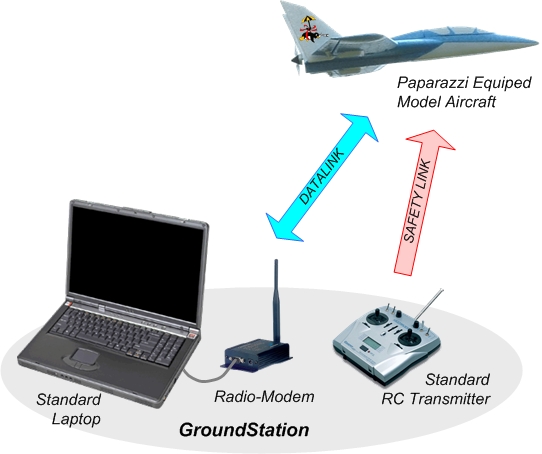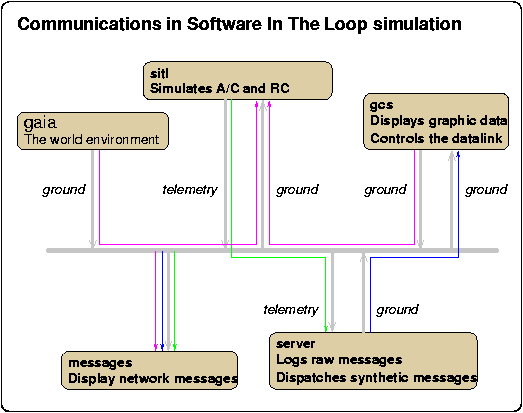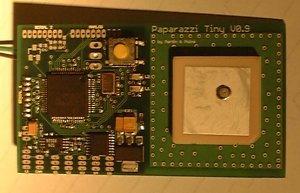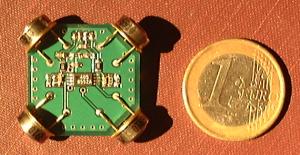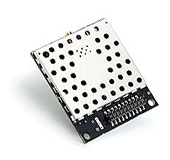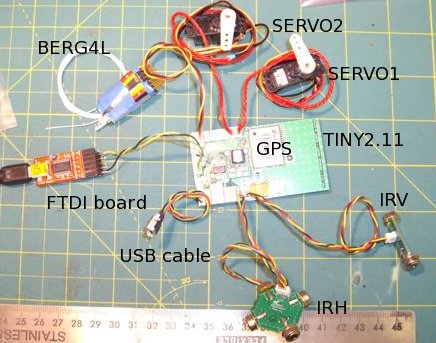Difference between revisions of "User:Scdwyer"
(testing tables) |
(started revamping system overview) |
||
| Line 16: | Line 16: | ||
---- | ---- | ||
= Scratch Area = | |||
= Overview = | |||
[[image:Paparazzi_System_overview.jpg|right|Paparazzi System Overview]] | |||
Paparazzi is a complete system of hardware and software for Unmanned Aircraft Systems (UAS), including both the airborne autopilot as well as complete ground station mission planning and monitoring software utilizing a bi-directional datalink for telemetry and control. | |||
== System Architecture == | |||
The following figure shows the main agents (processes or programs), of the system: one (or several) aircraft and the distributed ground architecture (usually distributed on a single computer): | |||
[[Image:Pprz_communication_agents.gif]] | |||
The UAV (in blue) is navigating autonomously and is monitored and controlled from the ground (in brown). The [[GCS|ground control station (GCS)]], or '''gcs''' agent, provides a graphical user interface with telemetry data received by the '''link''' agent which manages the ground-based radio modem. The '''link''' agent distributes telemetry data across the network (a single computer, a local network or the internet) where it can be used locally or remotely by the: | |||
* '''server''' - an agent that logs, distributes, and preprocesses these messages for the [[GCS]] and other agents | |||
* '''messages''' - a real-time numeric display of all telemetry data | |||
* A number of other useful agents, including: | |||
** a GCS-based flight plan editor to modify waypoints | |||
** a UAV [[Simulation|simulator]] to test flight plans and code modifications | |||
** a [[RTPlotter|real-time plotter]] for graphical telemetry data visualization | |||
** a [[Plotter|log plotter]] for graphical telemetry visualization after a flight | |||
All of these processes run simultaneously and each module is independently launched and configured from [[Paparazzi_Center]], where further detail can be found. | |||
First experiments with the system should be with the [[Simulation|'''simulator''']] where everything runs on a local machine. The configuration is then slightly different: | |||
[[Image:comm_sitl.gif]] | |||
Here the aircraft and its radio link are replaced by the [[Simulation|'''simulator''']]. An optional '''gaia''' agent is also available to introduce some environmental parameters such as wind, infrared contrast, GPS quality, and time scale reference. | |||
Because of the modular nature of the Paparazzi software suite, custom agents enhancing functionality are (relatively) easy to create and integrate with existing software. Some examples include: | |||
* a [[WeatherStationInterface|weather station interface]] | |||
* an external [[GPSd_position|gps position]] display | |||
* a [[Input2Ivy|joystick interface]] for controlling aircraft or payloads from the GCS | |||
== Aircraft == | |||
Paparazzi was originally designed for use with fixed-wing aircraft, but has since been expanded to include rotorcraft and work is underway to properly support hybrid aircraft. | |||
* explain about rotorcraft/fixedwing/hybrid, etc etc | |||
An example overview diagram of a fixed-wing system layout is presented. Different configurations are certainly possible! | |||
{| | |||
|- | |||
| [[image:Paparazzi_Equiped_Aircraft.jpg|Paparazzi Equipped Fixed-wing Aircraft]] | |||
| | |||
* '''A'''utopilot Control Board | |||
* '''B'''attery | |||
* '''D'''atalink Radio-Modem & Antenna | |||
* '''G'''PS Receiver | |||
* '''I'''R Sensor Board (if no IMU) | |||
* '''M'''otor & Controller | |||
* '''R'''C Receiver & Antenna | |||
* '''S'''ervos | |||
* '''P'''ayload (Example: Camera & Video Transmitter) | |||
|} | |||
=== The Airframe === | |||
The Paparazzi airborne system is highly configurable and can be used to autonomously operate almost any airframe. It is currently in use on airframes ranging from 20cm to 4.3m, and 100g to 25kg. In the early days of the project, slow and stable airframes such as the venerable Twinstar and Microjet were favored, but today the system is employed in a wide variety of high performance aircrafts, many with little or no natural stability, and many designed specifically around the Paparazzi system. | |||
The [[Gallery|User's Gallery]] shows some of the many Paparazzi aircraft. | |||
=== Airborne Electronics === | |||
===== Controller Board ===== | |||
[[image:tiny_proto1_top_small.jpg|frame|Tiny Controller Board]] | |||
Several controller boards have been designed to run the Paparazzi autopilot software, using either Atmel AVR or Philips ARM7 LPC micro-controllers. These boards include one or two micro-controllers and the required connectors to handle the servos, motor controllers, sensors, RC receiver, radio modem, and a variety of payloads. All of the [http://cvs.savannah.nongnu.org/viewcvs/paparazzi3/hw/?root=paparazzi schematics and PCB files] are available under the GPL licence. | |||
<br> | |||
More details on the controller boards are available on the [[Hardware|Hardware Pages]]. | |||
<br style="clear:both;"/> | |||
===== Sensors ===== | |||
[[image:ir_sensor_bot_small.jpg|frame|2 Axis IR Sensor Board]] | |||
Paparazzi autopilots can interface with virtually any type of sensor but the vast majority of applications rely on a set of 6 orthogonal infrared temperature sensors to estimate the orientation of the aircraft relative to the warm earth and cold sky. The IR system provides a robust and absolute attitude estimate that is immune to vibration and disorienting launches, wind gusts, or stalls that may confuse inertial-based autopilots. Paparazzi also uses conventional inertial systems on hovering aircraft such as quadrotors and helicopters with freely available [http://cvs.savannah.gnu.org/viewvc/paparazzi/paparazzi3/ software and hardware sources]. <br><br> Fixed wing airborne hardware typically includes infrared sensors, GPS & occasionally a gyroscope for roll or pitch rate damping on more agile aircraft. | |||
A standard GPS receiver from u-blox is used, either as a stand-alone unit for the [[Classix]] or [[Twog_v1|TWOG]] autopilots, or as a fully integrated package in the [[Tiny_v2|Tiny]] autopilot. | |||
More details on the sensors are available on the [[Sensors|Sensors page]]. | |||
<br style="clear:both;"/> | |||
===== Communications ===== | |||
[[image:ac4868_transceiver.jpg|frame|Aerocomm AC4868 Radio-Modem]] | |||
Airborne hardware also includes communications devices : Radio Modem (Datalink) & RC Receiver (Safety Link). | |||
Any wireless device providing a serial link can be used for the telemetry and the telecontrol (Datalink). | |||
More details on communications hardware are available on the [[Modems|Modems page]]. | |||
<br style="clear:both;"/> | |||
===== Example Setup ===== | |||
[[image:ppzsetup002.jpg|frame|Sample 2 servo setup]] | |||
A typical configuration would include two servos (elevon setup), receiver, IR sensors, FTDI or RF Modem for serial communications either wired or wireless. ESC is not shown. NOTE: DO NOT CONNECT POWER WIRE FROM ESC TO TINY. Only connect Ground and Signal for the ESC to the Tiny. | |||
<br style="clear:both;"/> | |||
=== Airborne Software === | |||
The Paparazzi autopilot provides the following features: | |||
* RC receiver (PPM signal) decoding | |||
* Servos and motor controller (PWM signal) control | |||
* Manual control with the RC | |||
* Control with augmented stability (named '''AUTO1''') | |||
* Autonomous navigation (named '''AUTO2''') in 3D, including | |||
** Waypoint navigation | |||
** Segment and circle navigation | |||
** Altitude hold, glide following | |||
** High level flight plan language execution (sequence, loops, goto...) | |||
* Telemetry to the ground station | |||
* Telecontrol (datalink) from the ground station (navigation control, waypoint modifications, tuning) | |||
The autopilot code is written in C while all the configuration code is translated from XML files at compile time. | |||
Code is segregated into two processes respectively handling the ''fly by wire'' (manual control) and the ''autopilot'' itself (stabilization and navigation). These processes are segregated on two-processor controllers such as the [[Classix|Classix]]. | |||
== Ground Control Station (GCS) == | |||
=== Ground Computer === | |||
The software is developped to be run on a i386 architecture with the [http://www.debian.org Debian GNU/linux] operating system. However a Live CD including all the software is provided: it should be able to boot any standard laptop. | |||
=== Ground Software === | |||
The software mainly provides | |||
* compiling tools to produce the airborne code from the configuration; | |||
* a GUI to control and interact with the UAV(s) during flight; | |||
* a basic simulator to ease the development of flight plans. | |||
=== Datalink === | |||
Paparazzi offers several possibilities to supervise the UAV flight from the ground. The default one uses a bidirectionnal wireless modem which supports both telemetry (downlink) and telecontrol (uplink). Thanks to this datalink, flight parameters are available in real time and full control of the navigation and tuning of one or several aircraft is possible from the ground station. | |||
=== Safety Link === | |||
The airborne hardware and software support the connection to a standard (patched) radio-control receiver. While this link is not required for actual autonomous flights, it may help during the tuning of a new aircraft and is usually considered as an important safety control redundancy. | |||
== Payloads == | |||
Paparazzi is designed to interface with a wide variety of payloads. The airborne board can control many servos for autonomous and/or manual [[Pan_Tilt_Camera|Pan/Tilt camera systems]] or other mechanical payloads, SPI, I<sup>2</sup>C, and GPIO connections are available to connect digital devices (i.e. lights or digital camera shutter), and analog inputs are available to interface with just about any sensor imaginable. The associated software is easily integrated into the open-source code. The [[Classix]] board can also be connected to a [http://www.gumstix.com Gumstix Computer] for highly sophisticated payload software applications. | |||
== Disclaimers == | |||
It should be understood that smooth, reliable autonomous flight is a great feat and will require significant time and effort to achieve, even with a highly evolved open system like Paparazzi. The time required will vary based on experience, aircraft, and luck. From experience however, users can expect to spend a similar amount of time learning and configuring Paparazzi as they may with any of the commercially available systems. | |||
Linux itself can pose quite a challenge to install, configure, and learn. To help ease the transition for those not already running Linux, the LiveCD option is available to help get you started. The LiveCD allows the user to save all configuration files as well as any user-modified source code on a pen drive or as a compressed file on your hard drive without affecting your existing OS. We strongly urge new users to [[Contact|Contact]] someone from the Paparazzi team before beginning any hardware investment as we can help you get the most out of the system. | |||
---- | |||
= Autopilot Feature Comparison Matrix = | = Autopilot Feature Comparison Matrix = | ||
Revision as of 22:29, 12 May 2012
About Me
- Name: Stephen Dwyer
- Location: Edmonton, Alberta, Canada
- Masters student in Mechanical Engineering at University of Alberta
- Member of the University of Alberta UAS Group
- Contact: scdwyerATualbertaDOTca
I have very little experience with Paparazzi thus far. I hope to remedy this in the near future, both for fun and (hopefully) as part of my Masters research. I have been following the wiki and mailing list for quite some time though.
I began working with small unmanned aircraft systems with the U of A Aerial Robotics Group, where I was team lead for 2 years, co-team lead for 1 year, and attended 3 AUVSI Student UAS competitions. We used the Micropilot MP2128g in our systems, and I gained valuable experience understanding the difficulty of autonomous system integration.
Current Work
I am working with two other students as part of a larger University of Alberta UAS Group to prepare a small demonstration platform. This UAV platform will be the beginning of an attempt to foster UAS research at our university, and provide an initial starting point for researchers from a variety of disciplines and departments to begin research on unmanned aircraft systems directly, or, more likely, investigate payloads and applications.
This unfortunately is taking most of my time (among other things like being a TA) and limits my personal system development. I am however looking forward to getting my Quadshot Expresso in the coming months!
Scratch Area
Overview
Paparazzi is a complete system of hardware and software for Unmanned Aircraft Systems (UAS), including both the airborne autopilot as well as complete ground station mission planning and monitoring software utilizing a bi-directional datalink for telemetry and control.
System Architecture
The following figure shows the main agents (processes or programs), of the system: one (or several) aircraft and the distributed ground architecture (usually distributed on a single computer):
The UAV (in blue) is navigating autonomously and is monitored and controlled from the ground (in brown). The ground control station (GCS), or gcs agent, provides a graphical user interface with telemetry data received by the link agent which manages the ground-based radio modem. The link agent distributes telemetry data across the network (a single computer, a local network or the internet) where it can be used locally or remotely by the:
- server - an agent that logs, distributes, and preprocesses these messages for the GCS and other agents
- messages - a real-time numeric display of all telemetry data
- A number of other useful agents, including:
- a GCS-based flight plan editor to modify waypoints
- a UAV simulator to test flight plans and code modifications
- a real-time plotter for graphical telemetry data visualization
- a log plotter for graphical telemetry visualization after a flight
All of these processes run simultaneously and each module is independently launched and configured from Paparazzi_Center, where further detail can be found.
First experiments with the system should be with the simulator where everything runs on a local machine. The configuration is then slightly different:
Here the aircraft and its radio link are replaced by the simulator. An optional gaia agent is also available to introduce some environmental parameters such as wind, infrared contrast, GPS quality, and time scale reference.
Because of the modular nature of the Paparazzi software suite, custom agents enhancing functionality are (relatively) easy to create and integrate with existing software. Some examples include:
- a weather station interface
- an external gps position display
- a joystick interface for controlling aircraft or payloads from the GCS
Aircraft
Paparazzi was originally designed for use with fixed-wing aircraft, but has since been expanded to include rotorcraft and work is underway to properly support hybrid aircraft.
- explain about rotorcraft/fixedwing/hybrid, etc etc
An example overview diagram of a fixed-wing system layout is presented. Different configurations are certainly possible!

|
|
The Airframe
The Paparazzi airborne system is highly configurable and can be used to autonomously operate almost any airframe. It is currently in use on airframes ranging from 20cm to 4.3m, and 100g to 25kg. In the early days of the project, slow and stable airframes such as the venerable Twinstar and Microjet were favored, but today the system is employed in a wide variety of high performance aircrafts, many with little or no natural stability, and many designed specifically around the Paparazzi system.
The User's Gallery shows some of the many Paparazzi aircraft.
Airborne Electronics
Controller Board
Several controller boards have been designed to run the Paparazzi autopilot software, using either Atmel AVR or Philips ARM7 LPC micro-controllers. These boards include one or two micro-controllers and the required connectors to handle the servos, motor controllers, sensors, RC receiver, radio modem, and a variety of payloads. All of the schematics and PCB files are available under the GPL licence.
More details on the controller boards are available on the Hardware Pages.
Sensors
Paparazzi autopilots can interface with virtually any type of sensor but the vast majority of applications rely on a set of 6 orthogonal infrared temperature sensors to estimate the orientation of the aircraft relative to the warm earth and cold sky. The IR system provides a robust and absolute attitude estimate that is immune to vibration and disorienting launches, wind gusts, or stalls that may confuse inertial-based autopilots. Paparazzi also uses conventional inertial systems on hovering aircraft such as quadrotors and helicopters with freely available software and hardware sources.
Fixed wing airborne hardware typically includes infrared sensors, GPS & occasionally a gyroscope for roll or pitch rate damping on more agile aircraft.
A standard GPS receiver from u-blox is used, either as a stand-alone unit for the Classix or TWOG autopilots, or as a fully integrated package in the Tiny autopilot.
More details on the sensors are available on the Sensors page.
Communications
Airborne hardware also includes communications devices : Radio Modem (Datalink) & RC Receiver (Safety Link). Any wireless device providing a serial link can be used for the telemetry and the telecontrol (Datalink).
More details on communications hardware are available on the Modems page.
Example Setup
A typical configuration would include two servos (elevon setup), receiver, IR sensors, FTDI or RF Modem for serial communications either wired or wireless. ESC is not shown. NOTE: DO NOT CONNECT POWER WIRE FROM ESC TO TINY. Only connect Ground and Signal for the ESC to the Tiny.
Airborne Software
The Paparazzi autopilot provides the following features:
- RC receiver (PPM signal) decoding
- Servos and motor controller (PWM signal) control
- Manual control with the RC
- Control with augmented stability (named AUTO1)
- Autonomous navigation (named AUTO2) in 3D, including
- Waypoint navigation
- Segment and circle navigation
- Altitude hold, glide following
- High level flight plan language execution (sequence, loops, goto...)
- Telemetry to the ground station
- Telecontrol (datalink) from the ground station (navigation control, waypoint modifications, tuning)
The autopilot code is written in C while all the configuration code is translated from XML files at compile time. Code is segregated into two processes respectively handling the fly by wire (manual control) and the autopilot itself (stabilization and navigation). These processes are segregated on two-processor controllers such as the Classix.
Ground Control Station (GCS)
Ground Computer
The software is developped to be run on a i386 architecture with the Debian GNU/linux operating system. However a Live CD including all the software is provided: it should be able to boot any standard laptop.
Ground Software
The software mainly provides
- compiling tools to produce the airborne code from the configuration;
- a GUI to control and interact with the UAV(s) during flight;
- a basic simulator to ease the development of flight plans.
Datalink
Paparazzi offers several possibilities to supervise the UAV flight from the ground. The default one uses a bidirectionnal wireless modem which supports both telemetry (downlink) and telecontrol (uplink). Thanks to this datalink, flight parameters are available in real time and full control of the navigation and tuning of one or several aircraft is possible from the ground station.
Safety Link
The airborne hardware and software support the connection to a standard (patched) radio-control receiver. While this link is not required for actual autonomous flights, it may help during the tuning of a new aircraft and is usually considered as an important safety control redundancy.
Payloads
Paparazzi is designed to interface with a wide variety of payloads. The airborne board can control many servos for autonomous and/or manual Pan/Tilt camera systems or other mechanical payloads, SPI, I2C, and GPIO connections are available to connect digital devices (i.e. lights or digital camera shutter), and analog inputs are available to interface with just about any sensor imaginable. The associated software is easily integrated into the open-source code. The Classix board can also be connected to a Gumstix Computer for highly sophisticated payload software applications.
Disclaimers
It should be understood that smooth, reliable autonomous flight is a great feat and will require significant time and effort to achieve, even with a highly evolved open system like Paparazzi. The time required will vary based on experience, aircraft, and luck. From experience however, users can expect to spend a similar amount of time learning and configuring Paparazzi as they may with any of the commercially available systems.
Linux itself can pose quite a challenge to install, configure, and learn. To help ease the transition for those not already running Linux, the LiveCD option is available to help get you started. The LiveCD allows the user to save all configuration files as well as any user-modified source code on a pen drive or as a compressed file on your hard drive without affecting your existing OS. We strongly urge new users to Contact someone from the Paparazzi team before beginning any hardware investment as we can help you get the most out of the system.
Autopilot Feature Comparison Matrix
A basic feature comparison table is presented to help in the autopilot hardware selection process. Stable well tested and used LPC or more cutting edge STM32 that requires some debugging.
For information regarding architecture and firmware compatibility of various subsystems and modules, please see the appropriate Subsystems overview and Modules List pages.
NOTE: The accuracy of this table may not be 100% correct, the best resource is always hardware and software source files and individual autopilot pages.
| Feature | Lisa/L v1.1 | Lisa/M v2.0 | Umarim v1.0 | Tiny v2.11 | TWOG v1.0 | YAPA v2.0 |
| MCU | ||||||
| Part | STM32F103RE | STM32F105RCT6 | LPC2148 | LPC2148 | LPC2148 | LPC2148 |
| Clock | 72MHz | 72MHz | 60MHz | 60MHz | 60MHz | 60MHz |
| Flash | 512kB | 256kB | 512kB | 512kB | 512kB | 512kB |
| RAM2 | 64kB | 64kB | 32kB & 8kB | 32kB & 8kB | 32kB & 8kB | 32kB & 8kB |
| Onboard Sensors3 | ||||||
| MEMS IMU | no | aspirin | yes | no | no | no |
| Baro | yes | yes | yes | no | no | no |
| Diff Pressure | yes | no | no | no | no | no |
| GPS | no | no | no | yes | no | no |
| Input/Output4 | ||||||
| UART | 3 & 1RX | 2 & 2RX | 2 | 1 | 2 | 2 |
| I2C | 2 | 1 + 15 | 2 | 1 | 1 | 1 |
| SPI | 2 | 1 | 1 | 1 | 1 | 1 |
| ADC | 3 (12bit) | 3 + 2 (12bit)5 | 0 + 4 (10bit)6 | 8 (10bit) | 8 (10bit) | 6 (10bit) |
| PWM | 6 | 6 + 25 | 6 | 8 | 8 | 10 |
| PPM Output | no | no | 1 | 1 | 1 | no |
| PPM Capture | 1 | 0 + 15 | 1 | 1 | 1 | 1 |
| GPIO7 | ? | 1 | 0 + 46 | 2 | 2 | 1 |
| Onboard LEDs | 8 | 5 | 2 | 3 | 3 | 3 |
| USB Peripheral | Onboard USB JTAG + UART | bootloader | bootloader | bootloader | bootloader | bootloader |
| CAN | 1 | 1 | no | no | no | no |
| Other | Overo w/ I/O incl. USB Host | Aspirin footprint, JTAG header | XBee connector, RS232 options | |||
| Power Management | ||||||
| Supply Input | 6.1V - 18V | 5V - 16V | 5.5V - 17V | 6.1V - 18V | 6.1V - 18V | 6.1V - 18V |
| Supply Output | 2.25@5V, 2.25A@3.3V, Other | 500mA@3.3V, 250mA@5V | 1A@3.3V, 1.5A@5V | 1A@3.3V, 2.25A@5V | 1A@3.3V, 2.25A@5V | 2x 1A@3.3V, 2.25A@5V |
| Software Switch | 2 | no | no | 1 | 1 | 1 |
| Mechanical | ||||||
| Size | ~100mm x ~50mm | 34mm x 60mm x 10mm | 56mm x 25mm | 70.8mm x 40mm | 40.2mm x 30.5mm | 80.0mm x 40.0mm? |
| Weight | ? | 9.9g - 10.8g | 9g | 24g | 8g | 23g w/ XBee? |
| Connector Style | Picoblade | Picoblade & 0.1" Servo | Picoblade | Picoblade | Picoblade | 0.1" Headers |
| PCB Style | 4-layer | 4-layer | 4-layer | 2-layer | 2-layer | 2-layer |
| Mounting Holes | 4x ?mm | 4x 2mm | 4x 2mm | no | no | 4x M3 |
| Comments | ||||||
| IMU and Overo Mount Location, Many Features | Onboard XBee connector allows clean and easy radio modem integration | |||||
Notes:
1. Only the newest revisions of the more commonly used autopilots are listed
2. The extra 8kB of RAM on the LPC2148 shared with the USB DMA
3. The onboard sensors are almost always supplemented with external sensors. For example, TWOG can use an external IMU or IR sensors, and also needs an external GPS.
4. Input/Outputs listed are generally those easily accessible on regular autopilot connectors, customization/hacks can modify available I/O, for example free an extra I2C on Tiny and TWOG
5., 6. Some features use shared resources - denoted by X + Y where Y is shared - and cannot be used simultaneously
5. Lisa/M v2.0 shared resources include: one I2C is shared with 2 PWM outputs, two ADCs are shared with LEDs, one RX only UART is shared with the PPM capture
6. Umarim v1.0 shared resources include: 4 ADCs are shared with 4 GPIOs
7. Usually other unused pins can be used for additional GPIO with some code modifications
| Autopilot Board | MCU | Onboard Sensors | ' | ' | ' | Input/Output | ' | ' | ' | ' | ' | ' | ' | ' | ' | ' | ' | Power Management | ' | ' | Mechanical | ' | ' | ' | ' | Comments |
| ' | Part | MEMS IMU | Baro | Diff Pressure | GPS | UART | I2C | SPI | ADC | PWM | PPM Output | PPM Capture | GPIO | Onboard LEDs | USB Peripheral | CAN | Other | Supply Input | Supply Output | Software Switch | Size | Weight | Connector Style | PCB Style | Mounting Holes | |
| Lisa/L v1.0 | STM32F1 | no | yes | yes | no | 3 & 1RX | 2 | 2 | 3 (12bit) | 6 | no | 1 | ? | 8 | Onboard USB JTAG + UART | 1 | Overo w/ I/O incl. USB Host | 6.1V - 18V | 2.25@5V, 2.25A@3.3V, Other | 2 | ~100mm x ~50mm | ? | Picoblade | 4-layer | 4x M3 | IMU and Overo Mount Location, Many Features |
| Lisa/L v1.1 | STM32F1 | no | yes | yes | no | 3 & 1RX | 2 | 2 | 3 (12bit) | 6 | no | 1 | ? | 8 | Onboard USB JTAG + UART | 1 | Overo w/ I/O incl. USB Host | 6.1V - 18V | 2.25@5V, 2.25A@3.3V, Other | 2 | ~100mm x ~50mm | ? | Picoblade | 4-layer | 4x M3 | IMU and Overo Mount Location, Many Features |
| Lisa/M v1.0 | STM32F1 | Aspirin | yes | no | no | 2 & 2RX | 1 + 1 | 1 | 3 + 2 (12bit) | 7 | no | 0 + 1 | 2 | 3 | needs mod | 1 | Aspirin footprint, JTAG header | 5V - 16V | 500mA@3.3V, 250mA@5V | no | 33mm x 56mm x 10mm | 9.9g - 10.8g | Picoblade + 0.1\" Servo | 4-layer | 4x 2mm | USB needs hardware mod to work |
| Lisa/M v2.0 | STM32F1 | Aspirin | yes | no | no | 2 & 2RX | 1 + 1 | 1 | 3 + 2 (12bit) | 6 + 2 | no | 0 + 1 | 1 | 5 | bootloader | 1 | Aspirin footprint, JTAG header | 5V - 16V | 500mA@3.3V, 250mA@5V | no | 34mm x 60mm x 10mm | 9.9g - 10.8g | Picoblade + 0.1\" Servo | 4-layer | 4x 2mm | |
| Booz | LPC2148 | Booz | yes | no | Booz | 2? | ? | ? | ? | ? | ? | ? | ? | ? | bootloader | no | ? | ? | ? | ? | ? | ? | Picoblade | ? | ? | Multi-board design |
| Umarim v1.0 | LPC2148 | yes | yes | no | no | 2 | 2 | 1 | 0 + 4 (10bit) | 6 | 1 | 1 | 0 + 4 | 2 | bootloader | no | 5.5V - 17V | 1A@3.3V, 1.5A@5V | no | 56mm x 25mm | 9g | Picoblade | 4-layer | 4x 2mm | ||
| Tiny v0.99 | LPC2148 | no | no | no | yes | 1 | 1 | 1 | 8 (10bit) | 6 | no | 1 | no | 2 | bootloader | no | Button, audio downlink | ? | ? | 1? | ? | ? | Picoblade | ? | no | Onboard GPS for cleaner integration |
| Tiny v1.1 | LPC2148 | no | no | no | yes | 1 | 1 | 1 | 8 (10bit) | 7 | no | 1 | no | ? | bootloader | no | Button | ?V - 20V | ?A@3.3V, 2A@5V | 1? | 63mm x 35mm | 25g | Picoblade | 4-layer | no | Onboard GPS for cleaner integration |
| Tiny v2.11 | LPC2148 | no | no | no | yes | 1 | 1 | 1 | 8 (10bit) | 8 | 1 | 1 | 2 | 3 | bootloader | no | 6.1V - 18V | 1A@3.3V, 2.25A@5V | 1 | 70.8mm x 40mm | 24g | Picoblade | 2-layer | no | Onboard GPS for cleaner integration | |
| TWOG v1.0 | LPC2148 | no | no | no | no | 2 | 1 | 1 | 8 (10bit) | 8 | 1 | 1 | 2 | 3 | bootloader | no | 6.1V - 18V | 1A@3.3V, 2.25A@5V | 1 | 40.2mm x 30.5mm | 8g | Picoblade | 2-layer | no | Offboard GPS to address interference or special installation | |
| YAPA v1.0 | LPC2148 | no | no | no | no | 2 | 1 | 1 | 5 (10bit) | 8 | no | 1 | no | 1 | bootloader | no | XBee connector, RS232 options | 6.1V - 18V | 2x 1A@3.3V, 2.25A@5V | 1 | 80.0mm x 40.0mm | 23g w/ XBee | 0.1\" Headers | 2-layer | 4x M3 | Onboard XBee connector allows clean and easy radio modem integration |
| YAPA v2.0 | LPC2148 | no | no | no | no | 2 | 1 | 1 | 6 (10bit) | 10 | no | 1 | 1 | 3 | bootloader | no | XBee connector, RS232 options | 6.1V - 18V | 2x 1A@3.3V, 2.25A@5V | 1 | 80.0mm x 40.0mm? | 23g w/ XBee? | 0.1\" Headers | 2-layer | 4x M3 | Onboard XBee connector allows clean and easy radio modem integration |
| Classix | LPC2148 x2 | no | no | no | no | 2 | 2 | 2 | 14 (10bit) | 6 | ? | 2 | ? | 2 | bootloader | no | Gumstix connector, audio downlink | 5V | 3.3V, 3.7V for Gumstix | no | 89mm x 30mm | 12g | Picoblade | ? | 4x ?mm | Dual MCU development board design |
| HB v1.0 | LPC2148 | yes | yes | yes | no | 2 | 2 | 2 | ? | ? | ? | 1 | ? | ? | bootloader | no | ? | ? | ? | ? | ? | Picoblade | ? | ? | Multi-board design |
Notes:
1. Only the newest revisions of the more commonly used autopilots are listed
2. The extra 8kB of RAM on the LPC2148 shared with the USB DMA
3. The onboard sensors are almost always supplemented with external sensors. For example, TWOG can use an external IMU or IR sensors, and also needs an external GPS.
4. Input/Outputs listed are generally those easily accessible on regular autopilot connectors, customization/hacks can modify available I/O, for example free an extra I2C on Tiny and TWOG
5., 6. Some features use shared resources - denoted by X + Y where Y is shared - and cannot be used simultaneously
5. Lisa/M v2.0 shared resources include: one I2C is shared with 2 PWM outputs, two ADCs are shared with LEDs, one RX only UART is shared with the PPM capture
6. Umarim v1.0 shared resources include: 4 ADCs are shared with 4 GPIOs
7. Usually other unused pins can be used for additional GPIO with some code modifications
| MCU | Clock | RAM | Flash | Used In |
| LPC21481 | 60MHz | 32kB + 8kB | 512kB | All Others |
| STM32F103RE | 72MHz | 64kB | 512kB | Lisa/L Series |
| STM32F105RCT6 | 72MHz | 64kB | 256kB | Lisa/M Series |
Notes:
1. The extra 8kB of RAM on the LPC2148 shared with the USB DMA
